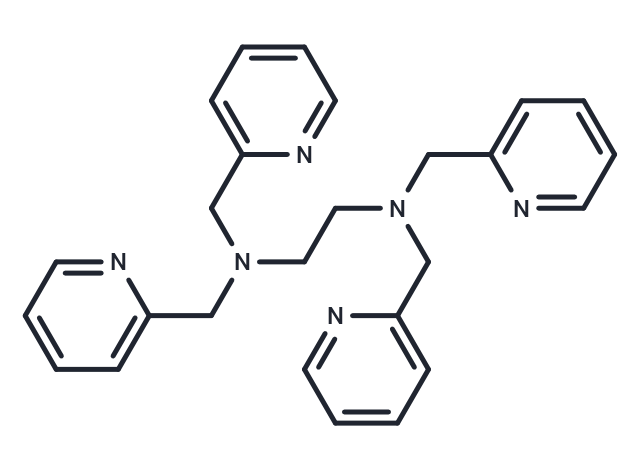购物车
- 全部删除
 您的购物车当前为空
您的购物车当前为空

TPEN (TPEDA) 是一种特定的细胞可渗透的重金属螯合剂,对 Zn2+具有高亲和力,但对 Mg2+和 Ca2+具有较低的亲和力。它诱导 DNA 损伤并增加细胞内ROS 的产生,还抑制细胞增殖并诱导凋亡。


为众多的药物研发团队赋能,
让新药发现更简单!
TPEN (TPEDA) 是一种特定的细胞可渗透的重金属螯合剂,对 Zn2+具有高亲和力,但对 Mg2+和 Ca2+具有较低的亲和力。它诱导 DNA 损伤并增加细胞内ROS 的产生,还抑制细胞增殖并诱导凋亡。
| 规格 | 价格 | 库存 | 数量 |
|---|---|---|---|
| 25 mg | ¥ 306 | 现货 | |
| 50 mg | ¥ 460 | 现货 | |
| 100 mg | ¥ 756 | 现货 | |
| 200 mg | ¥ 1,090 | 现货 | |
| 1 mL x 10 mM (in DMSO) | ¥ 376 | 现货 |
| 产品描述 | TPEN (TPEDA) is a specific cell-permeable heavy metal chelator. |
| 体外活性 | TPEN通过降低镉、汞和甲基汞引起的Fura-2荧光变化而表现出其效应。特别是在添加镉氯化物(10/30 μM)激发的细胞中,TPEN在暴露后3小时加入可以显著降低提升的Fura-2荧光比率至基础水平,在10分钟内降低至119.6±2.4%或109±1.5%(Δ比率(F340/F380)的降低)。此外,TPEN通过铜的氧化还原循环针对结肠癌细胞,依赖于剂量和时间减少细胞活性。TPEN引发的细胞死亡也依赖于铜的氧化还原循环,因为铜螯合剂neocuproine抑制了DNA损伤,并降低了pChk1、γ-H2AX和ATM蛋白表达。 |
| 激酶实验 | In a 96-well-plate, 40 nM USP2, 40 nM USP7, or 20 nM SENP2 is preincubated with a concentration range of NSC 632839 (NCI/NIH developmental therapeutics program) or control for 30 min before supplementation with an equal volume of 60 nM Ub-PLA2/40 μM NBD C6-HPC (USP2 or 7) or 20 nM SUMO3-PLA2/40 μM NBD C6-HPC (SENP2). Relative activity of the enzymes is determined by measuring the RFU values at single time points within the initial linear range (USP, 50 min; USP7, 50 min; and SENP2, 30 min). The RFU values within the initial linear range are normalized such that isopeptidase+vehicle=0% inhibition and isopeptidase+NEM=100% inhibition. The EC50 values are determined as above. The inhibitory activity of the test compound against the reporter enzyme PLA2 is performed as described above except there is no preincubation step and the data are normalized such that free PLA2+vehicle=0% inhibition and free PLA2+EDTA=100% inhibition. PLA2 activity is determined 8 min after the addition of the reagents[1]. |
| 细胞实验 | TPEN is dissolved in DMSO and then diluted with appropriate medium[1]. Human neuroblastoma cell line SH-SY5Y, are grown in Dulbecco's Modified Eagle's Medium (DMEM) mixed 1:1 with Ham's F-12 nutrient mixture containing 10% fetal bovine serum, 100 unit/mL penicillin and 100 μg/mL streptomycin at 37°C in a humidified 5% CO2 atmosphere. Two days before experimentation, cells are seeded at a density of 7×104 cells/cm2 in a 96-well plate. Cells in a 96-well plate are serum-starved for 4 hr; calcium indicator fura-2 is then loaded into the cells by using Calcium kit II fura-2. In brief, SH-SY5Ycells are incubated with 5 μM fura-2/AM in the presence of 0.04% Pluronic F-127, a dispersing agent to improve the efficiency of loading with fura-2, and 1.25 mM probenecid, a blocker of organic anion transport to prevent leakage of fura-2 from cells. After 1 hr incubation at 37°C, fura-2 fluorescence is measured at 500 nm emission after excitation at 340 nm (F340) or 380 nm (F380) using an Infinite M200 plate reader at 37°C.The change in [Ca2+]i is reflected by the ratio of F340 and F380. To determine the changes in fura-2 fluorescence ratio induced by heavy metal compounds, cells are treated with manganese chloride, lead acetate, cadmium chloride , mercuric chloride and MeHg chloride dissolved in distilled water. We confirmed that the cells adhered to the bottom of the plate after 6 hr exposure to heavy metal compounds. The cells are also treated with three Ca2+ channel blockers, lanthanum chloride dissolved in distilled water, verapamil and 2-APB dissolved in DMSO, 30 min before heavy metal exposure. The heavy metal chelator TPEN is dissolved in DMSO and added 3 hr after the stimulation with heavy metals to determine the contribution of endogenous and exogenous heavy metals on fura-2 fluorescence changes.We measured the effect of TPEN (20 μM) on the fura-2 fluorescence ratio after a 10 min treatment with TPEN, since our preliminary experiments showed that the effect of TPEN on fura-2 fluorescence reached maximum and stabilized within 10 min of the treatment[1]. |
| 别名 | TPEDA |
| 分子量 | 424.54 |
| 分子式 | C26H28N6 |
| CAS No. | 16858-02-9 |
| Smiles | C(CN(Cc1ccccn1)Cc1ccccn1)N(Cc1ccccn1)Cc1ccccn1 |
| 密度 | 1.3893 g/cm3 (Estimated) |
| 存储 | Powder: -20°C for 3 years | In solvent: -80°C for 1 year | Shipping with blue ice. | ||||||||||||||||||||
| 溶解度信息 | DMSO: 6 mg/mL (14.13 mM), Sonication is recommended. | ||||||||||||||||||||
溶液配制表 | |||||||||||||||||||||
DMSO
| |||||||||||||||||||||
评论内容